Top 5 2D Image to 3D Model Software
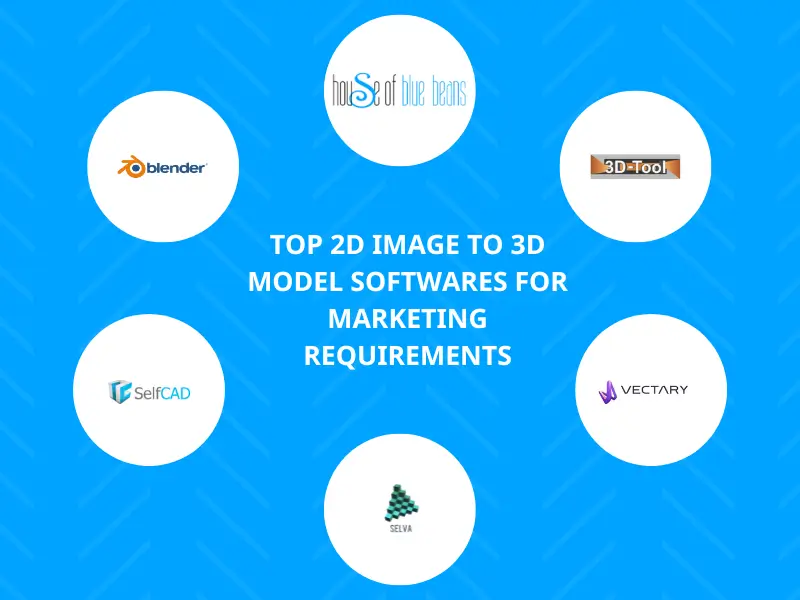
2D image to 3D model software enables users to create 3D models from 2D drawings or images. Today, many 2D image to 3D model software are available in the market, ranging from simple tools designed for hobbyists to more advanced software for professional use.
In this blog, we will discuss top software that you can use to fulfil your product visual requirements for your marketing purpose.
When we discuss with marketers and online sellers, the final use case for 3D models is to create visual content for product listings, marketing, and advertising.
Making 3D product models is the first step in creating different forms of visual content, like white background images, 360 spins, videos, and AR/VR experiences.
Before moving forward, let’s discuss the general process of converting 2D images to 3D models.
Process of 2D Image to 3D Model Conversion
Below is a high level explanation of the process of converting 2D images into 3D models:
- The first step in creating a 3D model from 2D images is to click 2D images using a camera.
- The next step is to import these 2D images into the 3D modeling software.
- Once the images have been imported, the next step is to create a basic 3D mesh, or wireframe, that follows the shape and contours of the object in the images. This can be done using polygons, curves, and extrusions.
- With the wireframe in place, the next step is to add detail to the 3D model. This can involve refining the shape and contours of the model, adding texture and materials, and adding finer details such as surface irregularities, bumps, and ridges.
- After the object is modeled you have to apply a 2D image as a texture to the 3D mesh. This gives the model the appearance and color information similar to the original image.
- Now, fine-tune the model. Once the texture is applied, you may need to refine the 3D wireframe to ensure that the texture is as per the geometry. Additional details, such as bumps, wrinkles, etc., can also be added.
- To see the outcome, you need to set up lighting and camera angle in a 3D scene and then render the 3D model. Lighting, materials, and other settings can be adjusted to achieve the desired appearance.
- Finally, export the 3D model. You can export the 3D model in a compatible format as per your use after you’re satisfied with the result.
The resulting 3D model can be viewed and manipulated from different angles and perspectives, providing a more immersive and interactive experience than a 2D image.
Overall, 3D asset creation from 2D images involves a complex, multi-step process requiring specialized software and expertise. There are other challenges with using the software alone.
Problems When You Go for Standalone Software Solution
When going for a standalone software solution to achieve this, there can be several problems that one may encounter.
- The process is time-consuming: Creating high-quality 3D models is time-consuming, especially for those new to 3D modeling and rendering. This is because the process involves multiple steps, such as creating a 3D model, adding textures, setting up lighting, and rendering the image. As a result, significant time and effort may be required to achieve the desired level and quality in the final output. Further, it is not even guaranteed that you’ll get desired results even after putting in so much effort and time.
- The process is resource intensive: High-quality 3D rendering requires powerful hardware, which is expensive. To render high-quality 3D images, a computer must have a powerful CPU, & GPU. It will also require a sophisticated server setup to manage, store and access large 3D files. These hardware requirements can be expensive, and not all computers may be able to meet them. Making such capital investment upfront would not make sense for many businesses.
- There may be quality issues: The quality of images is of utmost importance when choosing software that will help you sell your products. When it comes to 3D modeling, it can be a challenge to achieve a realistic and accurate representation of your product.
One of our customers, who earlier was using one such software, was facing three common problems while using it:
- The final images were not looking realistic.
- Any issues on the product’s surface were also coming in the 3D and, making it difficult to get rid of them.
- Inconsistent product visuals, making them unviable for commercial use.
- Most software have a steep learning curve: Learning 3D modeling software can be challenging and requires significant time and effort. It has a steep learning curve, especially for beginners. Becoming proficient in the software requires not only mastering the basic skills but also gaining an understanding of the advanced techniques and features available. This can require considerable dedication and practice to achieve–that may not be viable when your main goal for looking for the software is to create 3D models for marketing purposes.
What is the solution to these problems? Though you can spend time learning these software, mastering various techniques and developing expertise, this is a very long journey. If you just need 3D images to showcase your products on your website for marketing purposes, it’s not a wise choice.
Instead, you can hire a professional 3D product modeling provider for help. House of Blue Beans is one such agency.
House of Blue Beans – A Done-for-You CGI Agency for Your Product Visual Needs
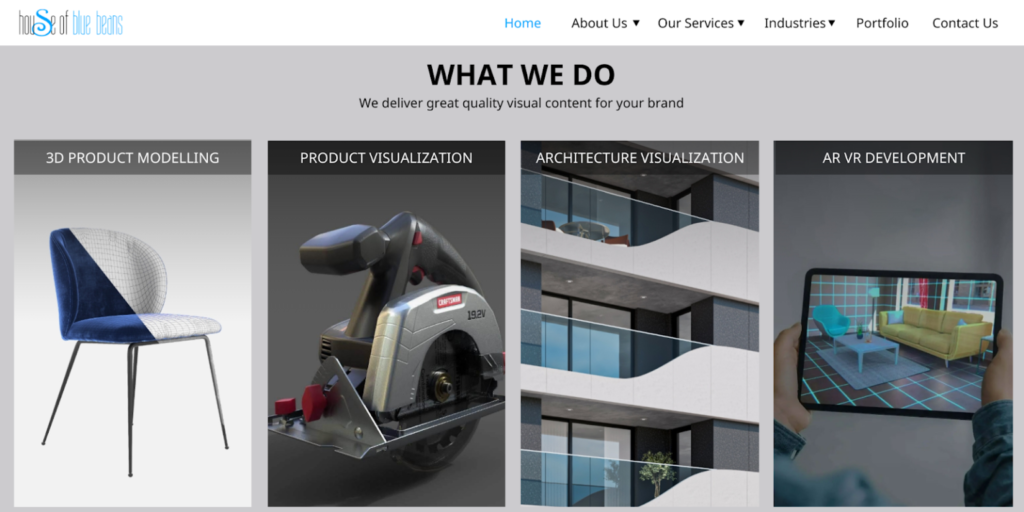
Here, done-for-you services refer to outsourcing the task of creating 3D models and any corresponding outputs—so that you can focus on strategic aspects of your work.
Some of the advantages of using our services for 3D model creation are:
- You get high-quality product models: We provide 100% accurate 3D models that match the physical product in terms of scale, proportions, texture, and finish. We have a team of highly experienced 3D artists with the necessary skills and expertise to create 3D models that can be used to create photoreal imagery and for virtual and augmented reality applications.
- It saves time for you: Outsourcing the task of creating 3D models to us saves you a lot of time, allowing you to focus on other aspects of your marketing strategy. House of Blue Beans helps you from creating 3D product models to producing white background images, lifestyle images, 360 spins, videos, AR/VR experiences and more to enhance your customers’ experiences and generate more sales.
- Our process & workflow is suited to requirements of any scale: Done-for-you services are scalable, meaning they can efficiently handle small and large volumes of 3D model creation. This can be especially beneficial for clients needing multiple images or projects requiring 3D images.
- Universal usable 3D model: In order to maximize ROI, it is imperative to create 3D models that can be used for both use cases. i.e., creation of photoreal marketing content and Augmented, Virtual reality & Metaverse applications. The 3D model required for both use cases has different specifications. Our 3D team has a proprietary process that enables us to create the 3D model with 2 different versions. i.e., A high fidelity 3D model that can be used to create marketing content and a low fidelity 3D model that can be used in AR & VR applications.
Overall, we provide 3D models that have 100% accuracy in terms of mimicking the physical product. This is the most important aspect of creating 3D models. 3D models are digital doubles/twins that can be used for creating marketing content, virtual selling experiences, etc. In either use case, if the 3D model is not 100% accurate, the end customer will have a poor buying experience.
We’ve worked with customers globally, including major players such as Lowe’s Home Improvements and Target Retail, to develop 3D product models that we’ve utilized to create engaging lifestyle images, videos, customized AR/VR experiences, and other innovative solutions to elevate their customers’ experiences.
Our expertise and reliability have earned us the trust of the most prominent brands in the industry.
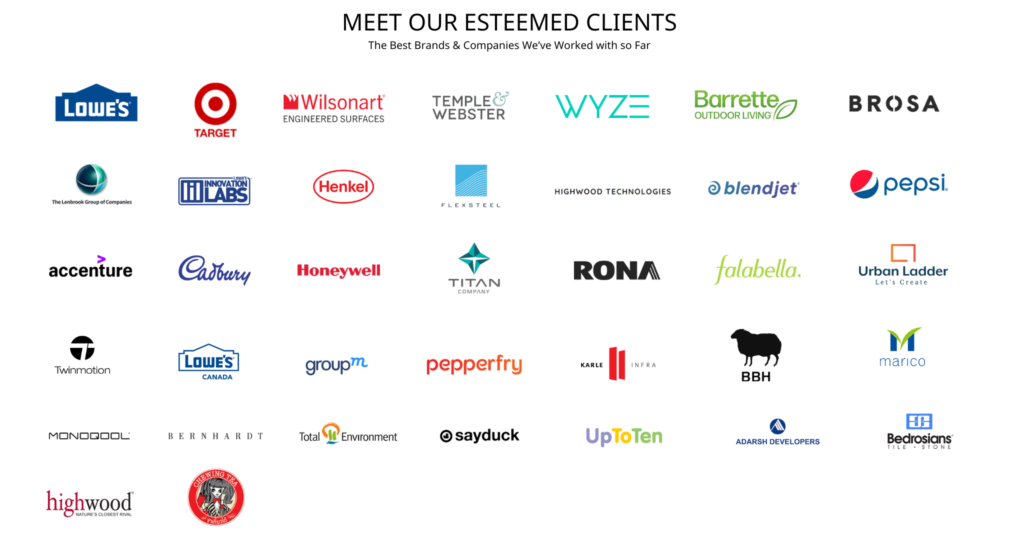
But how does HOBB make the process easy?
The overall process consists of just four steps.

All we need is a few inputs to get started and we create the 3D model for you.
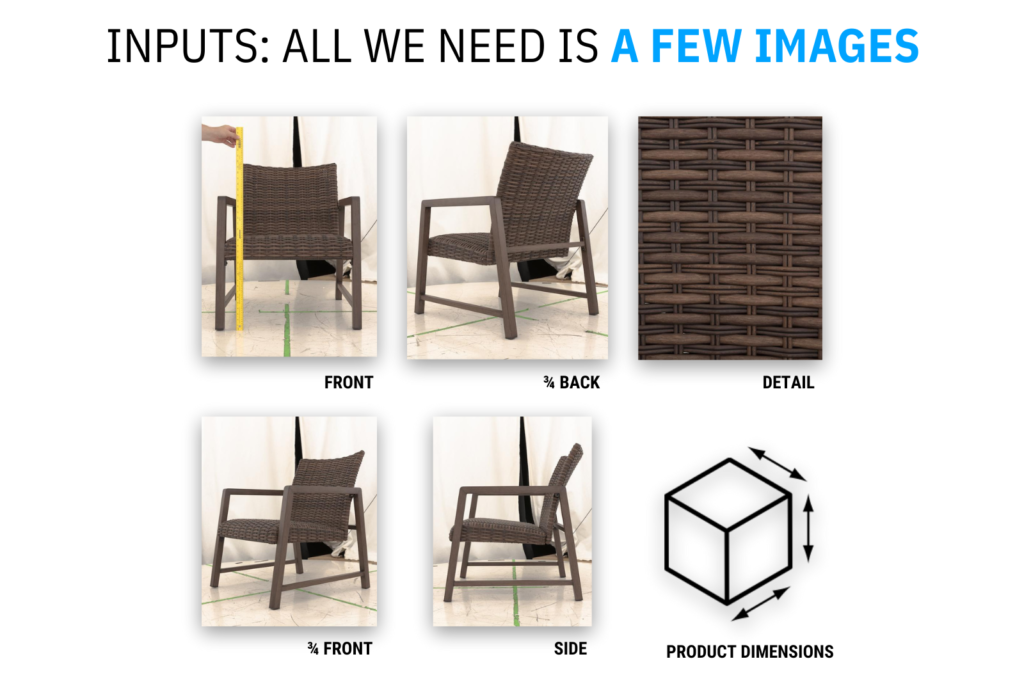
Some of the 3D models we have created for our clients:

3D models created by us (HOBB) are 100% accurate in terms of scale, size and shape when compared to the actual product. We use a proprietary 3D modeling pipeline that has generated over ~21,000 3D models for customers around the globe.
What types of 3D assets does HOBB provide?
We (HOBB) provide “High Fidelity,” “Variants,” and “Low Fidelity,” 3D models which are industry standard requirements needed t cover all business cases.

High Fidelity, Variants, and Low fidelity refer to different aspects of the process, from model complexity and performance to variations and aesthetics. These can help designers and artists create more efficient and effective 3D models.
- High fidelity 3D model is a version of the 3D model that contains all details of the physical product including minute details making it a perfect replica of the physical product. This version is often created in order to generate photorealistic renders of the product for marketing content. High fidelity 3D models are usually large files that are difficult to navigate and can cause performance issues if the hardware is not sophisticated. If this version is not created using an optimum approach, it can significantly slow the rendering process and cause performance issues. Create 3D models with a high polygon count for detailing, which aids in developing photorealistic visual material.
- Variants: These refer to multiple variations of a 3D model. These variations can include different shapes, sizes, colors, textures and materials. Variants are useful for creating product catalogs, demonstrating different options to clients, or creating multiple versions of the same model for use in different contexts.
- Low fidelity refers to a 3D modeling technique where models are created with optimum detail that is sufficient to run on represent the product on real time applications such as games, AR & VR applications. This is often done to improve performance, reduce file size, or create a specific aesthetic. The challenge with creating low fidelity 3D assets is to be able t balance between quality that is sufficient to create a ‘larger than life experience’ on one hand, and making sure that the file size is minimum for faster download and a smoother consumer experience on the other. Experienced 3D teams use proprietary pipelines and custom built tools to create low fidelity 3D models that meet industry standard requirements.
Once ready, we use the 3D model for various use cases:
- White background Silo images
- 360 spins
- Lifestyle images
- Videos
- AR & VR experiences




Top 5 2D Image to 3D Model Software
Now, let’s discuss the top 5 software solutions that can help you convert 2D images to 3D models.
1. Blender
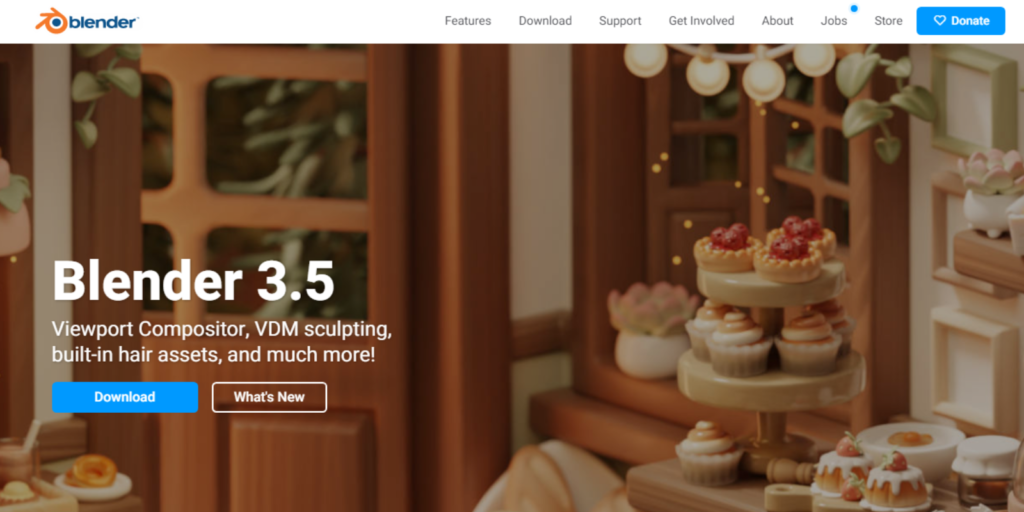
Blender is a free and open-source 3D modeling and animation software. It covers the complete 3D pipeline, including modeling, rigging, animation, simulation, rendering, compositing, motion tracking, video editing, and game development. Blender is a cross-platform application that works on Linux, Windows, and Macintosh computers. Its interface uses OpenGL to ensure a consistent user experience. Blender is ideal for individuals and small studios because of its unified pipeline and responsive development approach.
2. 3D-Tool
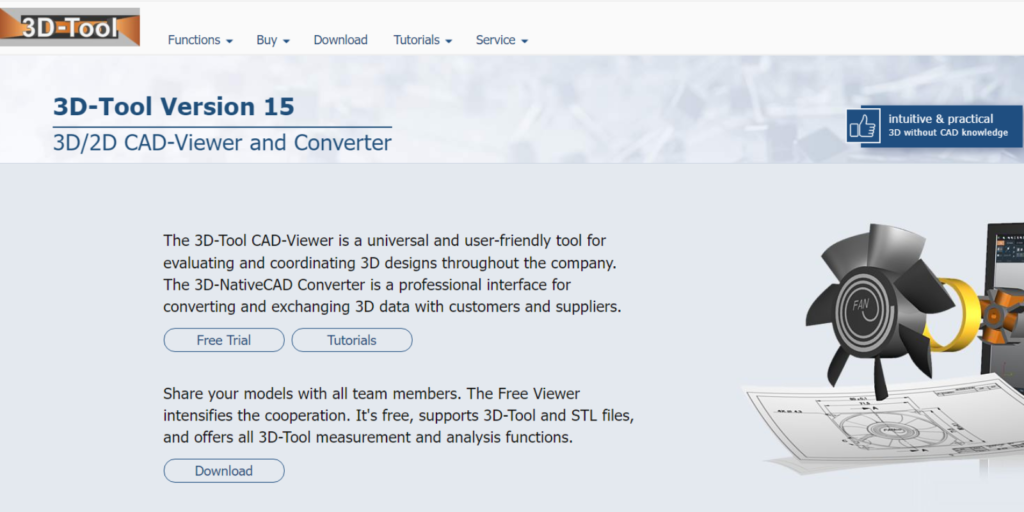
3D-Tool is a professional CAD viewer for 3D models and 2D drawings. With 3D Tool, you can convert 3D-CAD files to standard 3D exchange formats using the 3D-NativeCAD Converter. They also provide the same capabilities for viewing and analyzing 3D models and 2D drawings. The platform provides the 2D to 3D conversion in Basic, Advanced, and Premium versions. The 3DNativeCAD Converter is also included in the Premium Edition of 3D-Tool. The 3D-Tool Free Viewer is free, supports 3D-Tool and STL files, and offers all 3D-Tool measurement and analysis functions.
3. SelfCAD
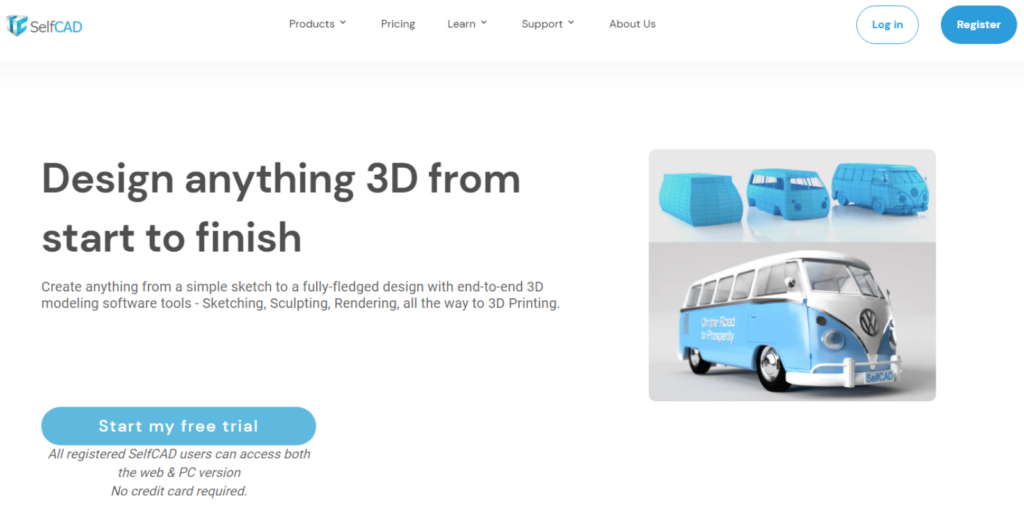
SelfCAD is a browser-based online CAD/CAM software that allows users to model, sculpt, slice, and print online. Additionally, customers do not need to spend months learning various difficult applications, nor are they required to pay hundreds of dollars for the opportunity. Users may build and print 3D models in a fraction of the time that standard CAD/CAM software applications would need.
4. Vectary
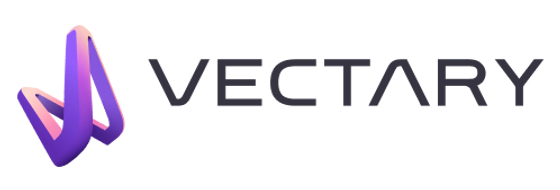
Vectary Studio is an online platform that creates and manages high-quality 3D visualizations from 2D sketches, logos, etc. The real-time webGL renderer gives quick visual feedback and rich materials that can be used to fine-tune your designs, whether imported, developed from scratch using 3D modeling tools in their online editor or built with ready-made pieces from their 3D asset catalog. You also get appealing 3D experiences, including no-code interactions, animations, and floating UIs.
5. Selva 3D
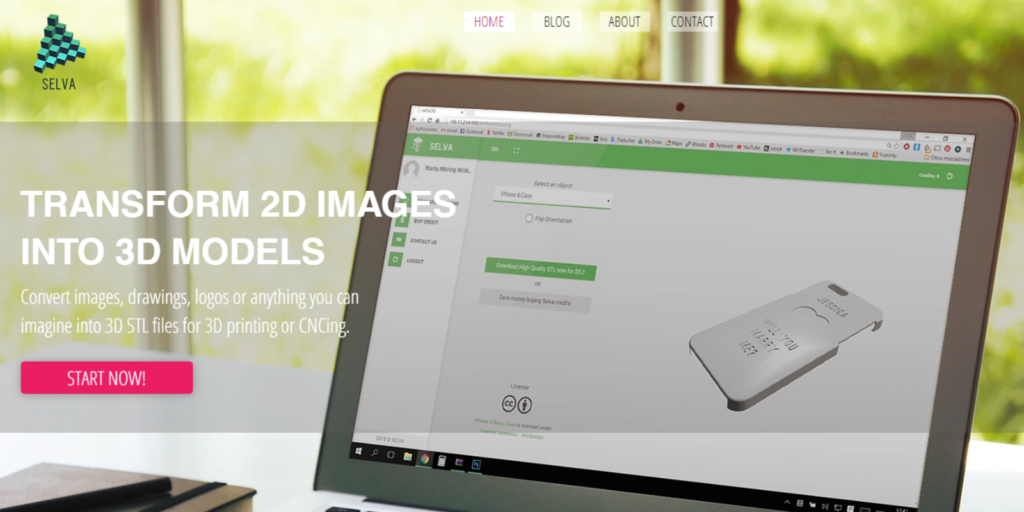
Selva 3D is a service provider that converts 2D photos into 3D printable files. It allows users to upload and transform 2D logos and drawings into 3D models. With Selva 3D, users can convert images, sketches, and logos into 3D STL files for 3D printing or CNCing. Selva3D is largely active in the technology business, but it also operates in the broad market segments of consumer, enterprise, and software.